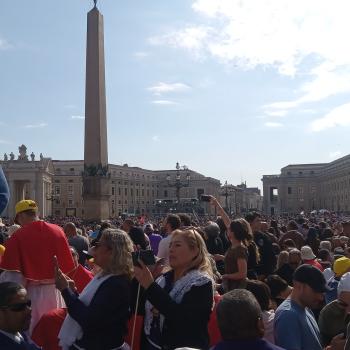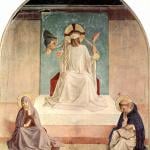Yesterday was the feast of St. Ignatius of Loyola, but due to the exuberant celebrations that tend to mark the day, we were unable to post anything. I would like to offer some reflections on what is something of a trademark of Ignatian spirituality, and that is devotion to the Trinity.
For starters, in his autobiography, paragraph 28, Ignatius recounts:
One day while he was reciting the Hours of our Lady on the steps of the same monastery, his understanding began to be elevated as though he saw the Holy Trinity under the figure of three keys. This was accompanied with so many tears and so much sobbing that he could not control himself. That morning he accompanied a procession which left the monastery and was not able to restrain his tears until dinner time. Nor afterwards could he stop talking about the Most Holy Trinity. He made use of many different comparisons and experienced great joy and consolation. The result was that all through his life this great impression has remained with him, to feel great devotion when he prays to the Most Holy Trinity.
Nor was this devotion a purely abstract reality. Each of the persons of the Trinity played a decisive role in the development of the Order and of Ignatius’ own spiritual journey. Pedro Arrupe was the first to highlight this in an article on the Trinitarian dimension of Jesuit spirituality.
Each of the persons of the Trinity played a decisive role in the development of the Order and of Ignatius’ own spiritual journey. Pedro Arrupe was the first to highlight this in an article on the Trinitarian dimension of Jesuit spirituality.
First, a few paragraphs further, while still at Manresa, and at prayer, Ignatius tells us that he “often and for a long time saw with the inner eyes the humanity of Christ…. If he were to say twenty, or even forty times, he would not venture to say that it was an untruth.” It is at Manresa that Ignatius put together the bulk of his Spiritual Exercises. These Exercises are essentially a mediation on the life of the Son, so as to lead the exercitant into making a well-discerned decision to follow Christ in a particular station of life. The graces received from the second person of the Trinity at Manresa were so strong that Ignatius goes on to note:
These things which he saw gave him at the time great strength, and were always a striking confirmation of his faith, so much so that he has often thought to himself that if there were no Scriptures to teach us these matters of faith, he was determined to die for them, merely because of what he had seen.
Second, Ignatius ultimately decided to go to Rome to place himself at the full disposal of the Pope for whatever use he had for him and his friends. While on his journey to Rome with Faber and Laynez, he stopped at La Storta, a few miles from Rome. (I recently received a new insight into the meaning of this place while reading The Count of Monte Cristo this summer. The count mentions that La Storta is the first point on the road leading to Rome from which one can see St. Peter’s basillica). While there, Ignatius had a vision of God the Father confirming his journey to Rome and promising him that he will “be propitious to him in Rome.” Ignatius recounts in paragraph 96 that “he felt such a change in his soul, and saw so clearly that God the Father placed him with Christ his Son, that he would not dare to doubt that the Father had placed him with his Son.” The Father had confirmed Ignatius’ mode of following his Son, and he would never again doubt it.
The third important moment comes from Ignatius’ Spiritual Diary. The Spiritual Diary is a small collection of Ignatius’ discernment of poverty in houses of Professed Jesuits. It tells us many important things about Ignatius’ own prayer life and spiritual experiences, particularly his relationship with the Holy Spirit. It is from there that we learn that he cried tears just about every mass to the point of almost losing his sight. Beginning at number 56 in the Diary, Ignatius speaks of what he calls loquela. This word translates from the Latin to English as “discourse, language, tongue.” In most translations of the Diary, it is left as loquela, since no one knows what Ignatius means by it.
It is worth quoting at some length from number 56:
Tears before Mass and during it an abundance of them, and continued, together with the interior loquela during the Mass. It seems to me that it was given miraculously, as I had asked for it that same day, because in the whole week, I sometimes found the externalloquela, and sometimes I did not, and the interior less, although last Saturday I was a little more purified….
Those of today seemed to be much, much different from those of former days, as they came more slowly, more interiorly, gently without noise or notable movements, coming apparently from within without my knowing how to explain them. In the interior and exterior loquela everything moved me to divine love and to the gift ofloquela divinely bestowed, with so much interior harmony in the interior loquela that I cannot begin to explain it…..
In the greater part of the Mass, no tears, but much loquela, but I fell into some doubt about the relish and sweetness of the loquela for fear it might be from the evil spirit, thus causing the ceasing of the spiritual consolation of tears. Going on a little further, I thought that I took too much delight in the tone of the loquela, attending to the sound, without paying so much attention to the meaning of the words and of the loquela; and with this many tears, thinking that I was being taught how to proceed, with the hope of always finding further instruction as time went on.
Coming from a Charismatic background, I have often thought that Ignatius was experiencing some kind of the gift of tongues, both interiorly and exteriorly. Whatever the case, he had a profound experience of the Holy Spirit which enabled him to make his decision about poverty in Jesuits Professed houses.
***
Devotion to the Trinity as such seems rare enough these days. Part of the difficulty I think is one of images that we use. I gave a talk to Seniors last year on relationship with God and encouraged them to pray with each of the Divine Persons individually. The one they had the most trouble with is the Holy Spirit. How does one speak intimately with a bird, or a flame, or a wind? The problem of image seems to go deep and often prohibits us from having a personal relationship with the Spirit.
However, if we meditate on the Annunciation, and realize that each of us as Christians is meant to place him or herself in the position of Mary, receptive to the revelation of God, we realize that unless we each become a spouse of the Spirit, we cannot bring forth Christ in our lives. We must not have only an intellectual relationship with the Holy Spirit, but an intimate, loving relationship. For that reason, at least for myself as a man, I have found that it helps to picture the Holy Spirit as a female being, as we often picture the Father as a male. Since there are really no gendered pronouns that tend to be symbolically associated with the Spirit, I think this can be helpful for prayer. I tend to have trouble meditating on the “overshadowing” of the Spirit as male. Of course, the sooner we get beyond gendering God in our personal prayer images (except for Jesus) the better.
The point is, Ignatius teaches us the need for a devotion to the Trinity, not for abstract theological purposes, but as an aid in daily discernment. Let us pray that we come to know the three Persons as closely as he.












